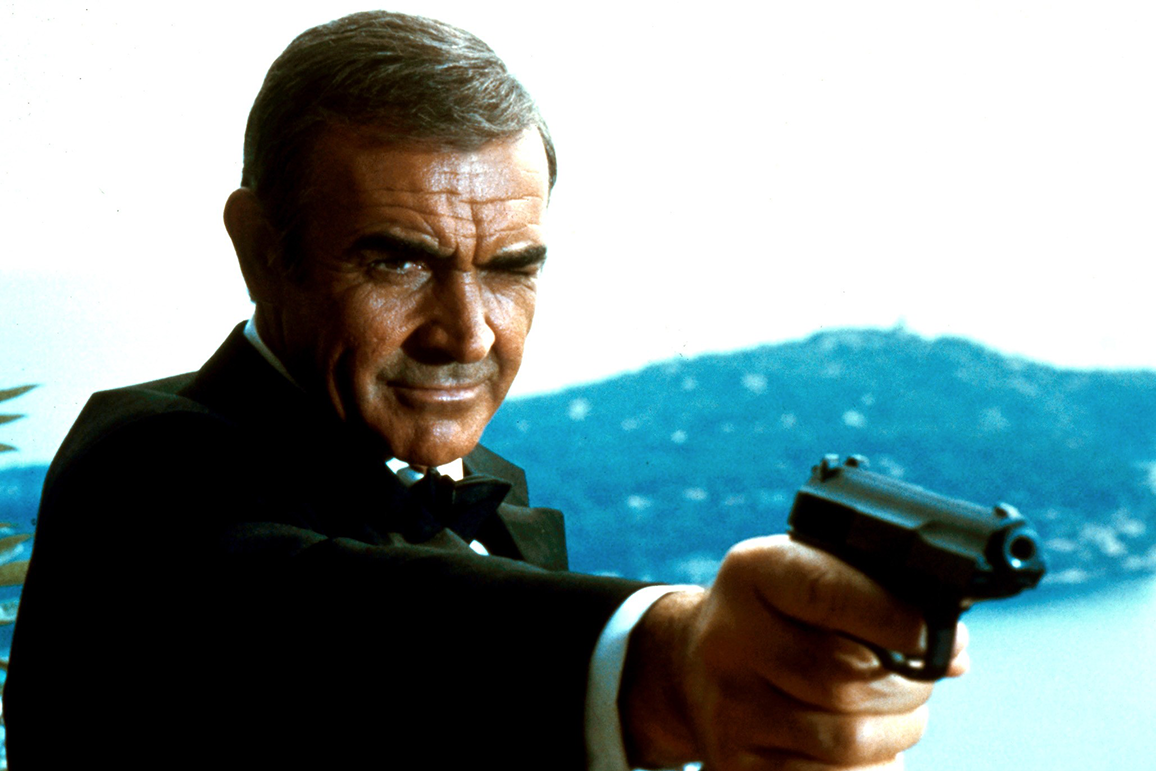Never Say Never Again (1983, Dir. Irvin Kershner):
Johnny Carson: Who was the first Bond villain?
Sean Connery (after a beat): Cubby Broccoli.
— The Tonight Show, 1983
Some things will never change. Some things will always be the same.
— Thomas Wolfe, You Can’t Go Home Again
Never Say Never Again was a long time in the making. Since 1975, producer Kevin McClory had fought a pitched legal battle against Ian Fleming’s estate and United Artists to get his own version of James Bond on the big screen. Armed only with the rights to Fleming’s Thunderball, McClory was nothing if not ambitious: he envisioned his own Bond franchise spun off from the novel, much like Sony has toyed with spinning off Spider-man’s rogue gallery into their own set of movies. When McClory teamed up with producer Jack Schwartzman (husband of Talia Shire and father of Jason Schwartzman) and the British High Court finally ruled in his favor, the die was cast: Albert “Cubby” Broccoli’s official Bond series, which had always concerned itself with lunatics trying to rule the world, was about to compete against a real-life megalomaniac.
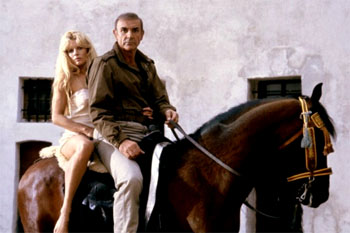 McClory might not have been a formidable talent (a prospectus of his career shows he never really accomplished anything outside of Bond), but he and Schwartzman were canny enough to assemble some major muscle for his production. They snapped up cinematographer Douglas Slocombe, who had just triumphed with Raiders of the Lost Ark, and pulled in Irvin Kershner (The Empire Strikes Back) to direct. Music would be supplied by Michel Legrand, who was about to win an Oscar for his work on Yentl (1983). Scripting duties were given to Lorenzo Semple, Jr., who had spent his career ricocheting between prestige and camp: the ’60s Batman TV series, Three Days of the Condor, Flash Gordon, The Parallax View. Big-time names joined the cast, including Max von Sydow and Edward Fox — certainly better than what Broccoli’s penny-pinching productions were capable of at the time. Most crucially, Sean Connery had agreed to strap on the Walther PPK again, immediately granting the film credibility. One could cynically suggest that Connery needed the work, as his most notable appearances in recent years had been in the box office bomb Meteor (1979) and a bit role in Time Bandits (1981). One thing for sure: he couldn’t resist sticking it to his former employer Broccoli, who he believed had bilked him by refusing to make him a co-producer in his Bond heyday. The year 1983 was shaping up to be manna for Bond film buffs — it would be 007 vs. 007, Roger Moore vs. Sean Connery, with arguments over the best Bond renewed, and perhaps settled for all time.
McClory might not have been a formidable talent (a prospectus of his career shows he never really accomplished anything outside of Bond), but he and Schwartzman were canny enough to assemble some major muscle for his production. They snapped up cinematographer Douglas Slocombe, who had just triumphed with Raiders of the Lost Ark, and pulled in Irvin Kershner (The Empire Strikes Back) to direct. Music would be supplied by Michel Legrand, who was about to win an Oscar for his work on Yentl (1983). Scripting duties were given to Lorenzo Semple, Jr., who had spent his career ricocheting between prestige and camp: the ’60s Batman TV series, Three Days of the Condor, Flash Gordon, The Parallax View. Big-time names joined the cast, including Max von Sydow and Edward Fox — certainly better than what Broccoli’s penny-pinching productions were capable of at the time. Most crucially, Sean Connery had agreed to strap on the Walther PPK again, immediately granting the film credibility. One could cynically suggest that Connery needed the work, as his most notable appearances in recent years had been in the box office bomb Meteor (1979) and a bit role in Time Bandits (1981). One thing for sure: he couldn’t resist sticking it to his former employer Broccoli, who he believed had bilked him by refusing to make him a co-producer in his Bond heyday. The year 1983 was shaping up to be manna for Bond film buffs — it would be 007 vs. 007, Roger Moore vs. Sean Connery, with arguments over the best Bond renewed, and perhaps settled for all time.
 Never Say Never Again is unique in the Bond film canon, and only partially because of its rogue status. The plot is inconsequential — in general form it follows the original Thunderball, but most of the film’s interest lies in its margins and subtext. It fascinates as a case study in stylistic remixing: ostensibly free to do what it likes away from the dictates of the official Bond series, the movie nevertheless must acknowledge the old conventions, given Connery’s connections and history. McClory and company aren’t above a bit of theft here and there — Max Von Sydow’s Ernst Stavro Blofeld pets a Persian cat, we have the usual flirty repartee between Bond and Miss Moneypenny (Pamela Salem), and we pay a visit to Q (a querulous Alec McGowan) in his workshop. All these bits are lifted straight from the EON productions’ playbook, and nowhere to be found in Thunderball the novel.
Never Say Never Again is unique in the Bond film canon, and only partially because of its rogue status. The plot is inconsequential — in general form it follows the original Thunderball, but most of the film’s interest lies in its margins and subtext. It fascinates as a case study in stylistic remixing: ostensibly free to do what it likes away from the dictates of the official Bond series, the movie nevertheless must acknowledge the old conventions, given Connery’s connections and history. McClory and company aren’t above a bit of theft here and there — Max Von Sydow’s Ernst Stavro Blofeld pets a Persian cat, we have the usual flirty repartee between Bond and Miss Moneypenny (Pamela Salem), and we pay a visit to Q (a querulous Alec McGowan) in his workshop. All these bits are lifted straight from the EON productions’ playbook, and nowhere to be found in Thunderball the novel.
In other ways, the film shakes up the formula, and the ultimate irony is that many of these tweaks would find their way into the official Bond series in the ’90s and beyond. Rather than the gruff father figure of years past, Edward Fox’s M is a technocrat who has grave doubts about Bond’s place in the modern age — a clear progenitor of Judi Dench’s “evil queen of numbers” M in the Pierce Brosnan movies. Like Brosnan’s GoldenEye and many of the subsequent Bond movies, Never Say Never Again openly questions whether time and the world have passed 007 by. “You’re a sexist, misogynist dinosaur,” Dench says to Brosnan, all of which apply to the Bond in Never Say Never Again — indeed, the opening sequence finds Connery failing a training exercise due to his weakness for the ladies. Or how about a black Felix Leiter? In Never Say Never Again‘s time, the idea might have seemed radical, but Bernie Casey nevertheless got the nod, paving the way for Jeffrey Wright’s Leiter in the Daniel Craig Bond films, and even opening the door to discussions of Idris Elba as James Bond.
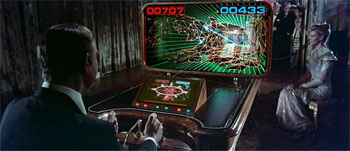 The movie also tries to keep pace with what’s hot circa 1983, with mixed results. Klaus Maria Brandauer’s Largo is more hip and youthful than your usual Bond villain: manic-depressive, twinkly, a mouthy entrepreneur who wraps his sweater around his neck like a prep-school refugee, he’s like the rich kid going up against Bond’s jock. Of course, the jock always gets the girl, and when Bond steals Largo’s mistress Domino (Kim Basinger in her first role) we witness a fit of pique that you don’t see too often from a Bond bad guy. He’s not necessarily the most menacing Bond antagonist, but he’s one of the most unique. In another concession to the times, we get that new-fangled thing called a video game: in place of the usual confrontation across the gaming tables, Bond takes on Largo via a shoot-’em-upcalled “Domination,” in which participants zap countries to gain their monetary wealth — a funny tip of the cap to the cynicism of Lorenzo Semple Jr.’s political thrillers.
The movie also tries to keep pace with what’s hot circa 1983, with mixed results. Klaus Maria Brandauer’s Largo is more hip and youthful than your usual Bond villain: manic-depressive, twinkly, a mouthy entrepreneur who wraps his sweater around his neck like a prep-school refugee, he’s like the rich kid going up against Bond’s jock. Of course, the jock always gets the girl, and when Bond steals Largo’s mistress Domino (Kim Basinger in her first role) we witness a fit of pique that you don’t see too often from a Bond bad guy. He’s not necessarily the most menacing Bond antagonist, but he’s one of the most unique. In another concession to the times, we get that new-fangled thing called a video game: in place of the usual confrontation across the gaming tables, Bond takes on Largo via a shoot-’em-upcalled “Domination,” in which participants zap countries to gain their monetary wealth — a funny tip of the cap to the cynicism of Lorenzo Semple Jr.’s political thrillers.
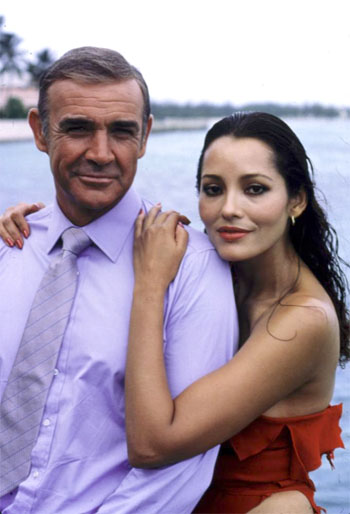 For more conventional villainy, we have Barbara Carrera’s Fatima Blush. Carrera gives a wickedly exaggerated performance, taking the Bond bad girl trope to its extreme conclusion — she’s ready to kill 007 at any moment, but she won’t stand for him claiming that she’s not the best lay he’s ever head (Bond reflects: “To be perfectly honest, there was this girl in Philadelphia…”). Bond might be showing his age, but he’s still sowing his oats: his love scenes with Fatima and a Bahamas local are a bit more spicy than we’re used to in a Bond picture.
For more conventional villainy, we have Barbara Carrera’s Fatima Blush. Carrera gives a wickedly exaggerated performance, taking the Bond bad girl trope to its extreme conclusion — she’s ready to kill 007 at any moment, but she won’t stand for him claiming that she’s not the best lay he’s ever head (Bond reflects: “To be perfectly honest, there was this girl in Philadelphia…”). Bond might be showing his age, but he’s still sowing his oats: his love scenes with Fatima and a Bahamas local are a bit more spicy than we’re used to in a Bond picture.
Never Say Never Again isn’t afraid to veer towards outright satire. Although the movie doesn’t do much with the idea of an older, more weathered Bond, it does mine some comic mileage from Bond’s attempts to clean himself up at a health clinic (“Too much white bread, red meat and dry martinits,” Fox’s M grumbles, to which Bond responds: “Then I shall cut out the white bread, sir”). An early brawl between 007 and a henchman ends with Bond triumphant after he throws his own urine sample in his assailant’s face. When a NATO computer is hacked and nuclear warheads are stolen, the mainframe offers a cheery “Have a nice day” to the criminal. Bond’s final confrontation with Fatima is a rare suspenseful moment — and then the suspense is deflated when it is revealed that Leiter was on the scene the whole time, ready to step in and save the day. Even Mr. Bean himself, Rowan Atkinson, shows up in the Bahamas as a klutzy desk jockey all too eager to point out that Bond’s reputation proceeds him: “You’re going to jeopardize the tourist trade if you go around killing people!”
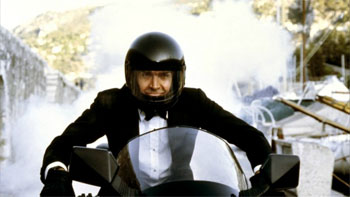 Fuse these interesting little odds and ends with some colorful characters, Slocombe’s slick, professional cinematography, and the return of Connery, and you would think Never Say Never Again is a superior Bond product. Sadly, it never coalesces into a coherent whole. The script wants it both ways, poking irreverent fun at the Bond mythos even as it follows the usual gameplan, and those mixed signals prevent the film from taking flight. While lots of things happen in Never Say Never Again, the plot is sabotaged by dodgy special effects (a falling horse is particularly egregious) and a curious lack of urgency. We get a few requisite chases, a few fistfights, a few exotic locations, yet by the time we meander into the grand finale in an underground cavern, you’d be hard-pressed to find a pulse. Legrand’s out-of-time soundtrack doesn’t help: its collision of orchestral passages, calypso, and Gallic jazz doesn’t suit the goings-on, and Lani Hall’s title track is pure adult contemporary — and one of the most un-apropos Bond themes ever. Attempting to carry the film on his back like Atlas, Connery is game, and as usual his Bond is a pleasure to be around, all sardonic wit and effortless charisma. Still, he seems faintly embarrassed to be there, as if he recognizes he’s an old man trying to play a kid’s game.
Fuse these interesting little odds and ends with some colorful characters, Slocombe’s slick, professional cinematography, and the return of Connery, and you would think Never Say Never Again is a superior Bond product. Sadly, it never coalesces into a coherent whole. The script wants it both ways, poking irreverent fun at the Bond mythos even as it follows the usual gameplan, and those mixed signals prevent the film from taking flight. While lots of things happen in Never Say Never Again, the plot is sabotaged by dodgy special effects (a falling horse is particularly egregious) and a curious lack of urgency. We get a few requisite chases, a few fistfights, a few exotic locations, yet by the time we meander into the grand finale in an underground cavern, you’d be hard-pressed to find a pulse. Legrand’s out-of-time soundtrack doesn’t help: its collision of orchestral passages, calypso, and Gallic jazz doesn’t suit the goings-on, and Lani Hall’s title track is pure adult contemporary — and one of the most un-apropos Bond themes ever. Attempting to carry the film on his back like Atlas, Connery is game, and as usual his Bond is a pleasure to be around, all sardonic wit and effortless charisma. Still, he seems faintly embarrassed to be there, as if he recognizes he’s an old man trying to play a kid’s game.
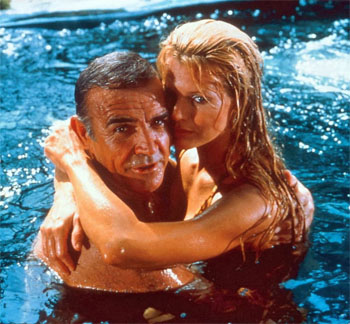 Never Say Never Again was not a happy experience for its participants: budget and schedule overruns led to Kershner’s unofficial sacking as director (it’s been rumored that Connery helped direct the film after Kershner was released), and while the movie got a decent box office return, it hasn’t received much attention or critical acclaim since. McClory would refuse to give up the ship: until his death in 2006, he would threaten to make more Bond movies, and every so often he would throw out the idea of casting a former Bond (Brosnan, Timothy Dalton) in the lead role. That was the sort of trick that would only work once, though, and never again would he get an opportunity to produce a film. As for Connery, it would be “never again” of a different sort. “Never?” Basinger mischievously says to him in the movie’s final moments, and Connery, breaking the fourth wall, gives the audience a wink that holds out hope that maybe, just maybe, his Bond would be back. It was not to be, and audiences were all the better for it; he would reinvent his career with The Untouchables, and finally outgrow his Bond legacy, if not completely escape it. ■
Never Say Never Again was not a happy experience for its participants: budget and schedule overruns led to Kershner’s unofficial sacking as director (it’s been rumored that Connery helped direct the film after Kershner was released), and while the movie got a decent box office return, it hasn’t received much attention or critical acclaim since. McClory would refuse to give up the ship: until his death in 2006, he would threaten to make more Bond movies, and every so often he would throw out the idea of casting a former Bond (Brosnan, Timothy Dalton) in the lead role. That was the sort of trick that would only work once, though, and never again would he get an opportunity to produce a film. As for Connery, it would be “never again” of a different sort. “Never?” Basinger mischievously says to him in the movie’s final moments, and Connery, breaking the fourth wall, gives the audience a wink that holds out hope that maybe, just maybe, his Bond would be back. It was not to be, and audiences were all the better for it; he would reinvent his career with The Untouchables, and finally outgrow his Bond legacy, if not completely escape it. ■

